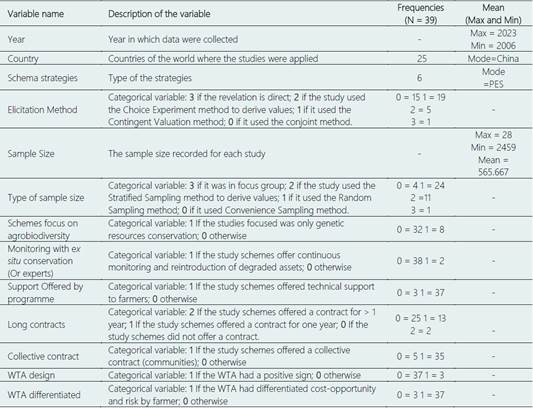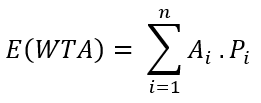1. Introduction
Agriculture is currently facing unprecedented challenges due to rapidly increasing human population and unstable growth environment (Ramankutty et al., 2018; Struik & Kuyper, 2017). To address the increasing worldwide demand for food, the strategy applied by many countries where high levels of agrobiodiversity (Table 1) exist is to expand the distribution of more productive and modern crop varieties, which can increase production (Joshi et al., 2020b; Yang et al., 2020). However, most of these intensified agriculture practices do not implement plans for conservation of high levels of agrobiodiversity. Thus, risk of irreversible loss of some species and rare varieties in the national and international market appears (Egli et al., 2018). This risk increases when many custodian farmers (Table 1) prioritise increase in their income, and focus on agricultural intensification (Ebert et al., 2023; Singh et al., 2019; Sumalan et al., 2021) by modifying their product portfolio into monoculture systems or homogenising their crop varieties (Bedoya-Perales et al., 2018; Gajanana et al., 2015).
Table 1. Main concepts in the management and overall cost of agrobiodiversity on farm integrated to conservation
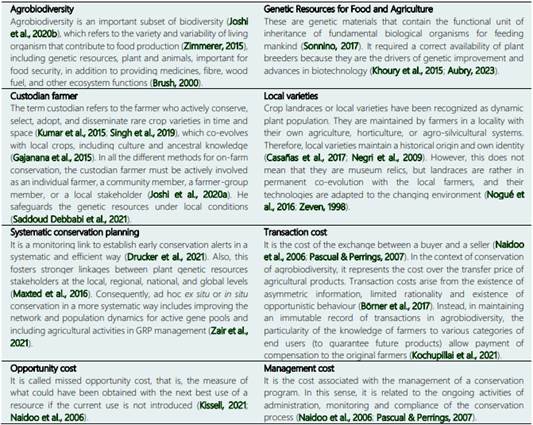
Other drivers of change in agrobiodiversity include changes in occupation, migration and abandonment of agricultural knowledge typical of landraces (Castillo et al., 2021; Guzzon et al., 2021; Zimmerer et al., 2019). Moreover, agrobiodiversity is also impacted by natural and man-made disasters, epidemics, pests, war or insurgency and over-exploitation of land due to overgrazing (Joshi et al., 2020a; Tiemann et al., 2015). Similarly, sufficient evidence supports that climate-change factors such as changes in precipitation, humidity, high and low temperatures and deglaciation influence the current vulnerability of agricultural systems (Lozano-Povis et al., 2021). Thus, a 2% reduction in agricultural production every decade due to climate change has been reported (Pachauri et al., 2014).
All these aforementioned threats could lead to a decrease in agrobiodiversity, that is, they directly cause loss of genetic diversity, which results in the extinction of varieties that carry genes that are important for genetic improvement of crops to increase global production (Brush, 2000; Zimmerer & De Haan, 2017). These plant genetic resources (PGRs) are widely used for food and agriculture, thus, there is a need to ensure that crops adapt to the challenges of sustainably producing more food using fewer inputs and adapting to climate change, changes in consumption patterns and overarching threats related to emerging diseases (Ebert, 2020). In summary, the success of crop-breeding programmes, among others, mainly depend on the availability of genetic variability for different traits of interest (Nordhagen et al., 2017; Sumalan et al., 2021).
Although in the last four decades, many organisations and individuals worldwide have concentrated their efforts on conserving samples in ex situ conservation programmes through germplasm banks and in protected areas (in situ or on-farm conservation), these efforts do not actively conserve all genetic diversity (Brush, 2000; Engels & Ebert, 2021b; Rojas et al., 2014). Many researchers point out that in the planning of proposed conservation programmes, especially in developing countries, a profound change is needed to transition from the current ex situ conservation to a more systematic and complimentary basis for the management of crop wild relatives (Rometsch et al., 2023) and native varieties (Maxted & Brehm, 2022). These processes involve both evidencebased conservation using ex situ and in situ (on-farm) techniques to conserve the range of diversity in PGRs (Dulloo, 2021; Rajpurohit & Jhang, 2015). This systematic conservation planning (Table 1) incorporates the role of custodian farmers in the conservation process because of their great importance in the co-evolution of genetic resources (Sumalan et al., 2021). In addition, in situ conservation can maintain cultural and heritage attributes (Brush, 2000; Madden, 2019; Pallante et al., 2016).
In situ conservation focuses on rescuing/ supporting custodian farmers that are only present in some rural areas in each country; however, a conservation plan cannot be established for free (Pascual & Perrings, 2007). Whereas many of these custodian farmers have implemented government policies that focus on an incentive mechanism that improves their status quo, these policies are prone to inefficiency in terms of cost. Some researchers suggest that the opportunity-cost-and-benefit analysis of conservation can play an important role in concentrating efforts to this important agrobiodiversity-conservation task (Juvančič et al., 2021; Narloch et al., 2011; Padulosi & Drucker, 2018; Pallante et al., 2016; Tyllianakis & Martin-Ortega, 2021). Therefore, available studies that focused on the opportunity-cost-and-benefit as factors that influence the willingness of farmers to agree to adapt more systematic in situ conservation programmes of plant genetic resources were reviewed.
By exploring the literature, the aim of this review was to identify gaps in the literature on the methods of determining the opportunity costs (Table 1) and benefits obtained by custodian farmers through their willingness to accept (WTA) compensation that is closer to the true indicator of the costs incurred by them in providing the in situ conservation service for agrobiodiversity.
2. Methodology
This study is based on a literature review. First, it was defined the most used terms that fit into the planning of in situ (on-farm) conservation systems by custodian farmers in a more systematic and integrated of plant genetic resources conservation approach (Table 2).
Table 2. Criteria for inclusion of references in this section
| Criteria | Inclusion | N° articles |
|---|---|---|
| Population | Farmers | General |
| Intervention | On farm, agricultural, and ex situ conservation. | General |
| Used tools | Contract auctions to reveal farmers’ willingness | General |
| Collective information | Stated preference methods | General |
| Study design | Economic evaluation (WTA) and models for evaluating determinants | General |
| First main words | Plant genetic resources in situ (on farm) and ex situ conservation | 457 |
| Second main words | WTA for crop genetic resources conservation on farm* | 40 |
* Some studies were about agrobiodiversity conservation, but at least one of the objectives was to maintain local crop varieties and their wild relatives.
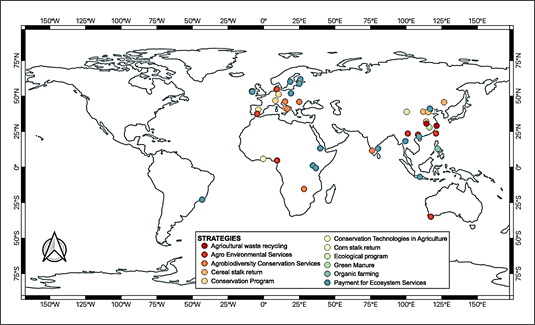
Figure 1 Global distribution of studies regarding farmers’ willingness to accept compensation for the management of agrobiodiversity. The 11 strategies identified are listed within the legend with different symbol colours in the map.
This approach facilitates the linkages between in situ and ex situ conservation methods, thus promoting participatory manage-ment of PGRs. Then, this approach was associated to the analysis of benefits (public and private) of in situ conservation to illustrate the net benefits for custodian farmers who decide to provide the conservation service of local breeds and wild crops. Finally, the opportunity costs by the farmers in conserving agrobiodiversity was reviewed, which is related to the approaches of their WTA compensation and participation in providing conservation service, thus revealing the opportunity costs to the farmers. This review focuses on published literature about farmer incentive tools based on stated preference methods. To achieve this objective, the SPIDER tool was used (Methley et al., 2014) to identify studies that focus on the WTA compensation of farmers who provide the service of plant genetic resources conservation, which incorporates the benefits.
This study aims to provide a complete characterisation of the management status of PGR conservation and agrobiodiversity for the adoption of plant genetic resources conservation programmes by farmers. Hence, only up-to-date conservation (in situ and ex situ) information was used. In addition to the identification of public benefits in an integrated conservation system and opportunity costs for the provision of conservation service, some criteria were applied, Table 2 lists the inclusion criteria used in the eligibility screening.
3. The breadth of studies on farmers’ WTA compensation for management of agrobiodiversity
The descriptive statistics of the studies found in this subject are listed in Table 3. The complete list of studies reviewed can be found on Appendix A. The information that they contain comes from 28 countries in the world, of which 14 of them were registered in China (Figure 1), and covers the period from 2006 to 2023.
The type of strategy in the WTA compensation proposal practiced during the development stage comes from 14 studies that referred to payments for ecosystem services, and nine studies on agro-environmental-services. Three investigations were carried out for ecological programmes, and eight studies were performed for sustainable use of agricultural residues. Five studies focused on agrobiodiversity conservation in which three were related to PGRs and two were related to animal genetic resources (Table 4).
Table 4. WTA compensation from farmers based on the proposed scheme
| Authors of the study | Sample Size | Sampling Method | Elicitation Method | WTA (USD/ha/Year)* | Strategy Practice** |
| Moukam (2021) | 595 | Random Sampling | Contingent | 7.92 | AES |
| Niskanen et al. (2021) | 591 | Random Sampling | Conjoint | 1113.34 | AES |
| Nong et al. (2021) | 209 | Stratified Sampling | Choice Experiment | 209.37 | AES |
| Sun et al. (2021) | 28 | Convenience sampling | Conjoint | 27.45 | AES |
| McGurk et al. (2020) | 800 | Random Sampling | Contingent | 99.56 | AES |
| Latacz-Lohmann & Breustedt (2019) | 292 | Random Sampling | Conjoint | 23.63 | AES |
| Villanueva et al. (2015) | 295 | Stratified Sampling | Conjoint | 171.31 | AES |
| Christensen et al. (2011) | 444 | Random Sampling | Conjoint | 527.97 | AES |
| Chu et al. (2020) | 249 | Random Sampling | Contingent | 1,111.97 | PES |
| Geussens et al. (2019) | 150 | Stratified Sampling | Conjoint | 75.51 | PES |
| Haile et al. (2019) | 200 | Random Sampling | Conjoint | -9.87 | PES |
| Hasler et al. (2019) | 2439 | Stratified Sampling | Choice Experiment | -293.462 | PES |
| Villamayor-Tomas, et al. (2019) | 1980 | Random Sampling | Choice Experiment | 723 | PES |
| Da Motta &Ortiz (2018) | 1079 | Convenience Sampling | Contingent | 57.22 | PES |
| Feng et al. (2018) | 391 | Random Sampling | Contingent | 1767.4623 | PES |
| Kanchanaroek &Aslam (2018) | 529 | Random Sampling | Conjoint | -886.86 | PES |
| Li et al. (2018) | 296 | Random Sampling | Contingent | 1180.98 | PES |
| Nyongesa et al. (2016) | 200 | Random Sampling | Contingent | 88.636 | PES |
| Buckley et al. (2012) | 247 | Random Sampling | Contingent | 1699.33 | PES |
| Krishna et al. (2013) | 454 | Random Sampling | Contingent | 172.973 | PES |
| Jiang et al. (2021) | 1288 | Stratified Sampling | Conjoint | 111.25 | Stalk return |
| Tao &Wang (2020) | 453 | Random Sampling | Contingent | 184.01 | Waste recycling |
| Wang et al. (2020) | 513 | Random Sampling | Conjoint | 1565.68 | Stalk return |
| Yang et al. (2020) | 925 | Stratified Sampling | Conjoint | 111.32 | Stalk return |
| Zuo et al. (2020) | 480 | Stratified Sampling | Contingent | 31.91 | Stalk return |
| Giannoccaro et al. (2017) | 203 | Stratified Sampling | Contingent | 17.02 | Stalk return |
| Huang et al. (2019) | 601 | Stratified Sampling | Contingent | 67.66 | Stalk return |
| He et al. (2016) | 812 | Random Sampling | Contingent | 74.08 | Waste recycling |
| Li et al. (2021) | 1711 | Random Sampling | Contingent | 704.02 | EP |
| Li et al. (2020) | 1350 | Random Sampling | Conjoint | 469.48 | EP |
| Yamota &Tan-Cruz (2007) | 110 | Random Sampling | Contingent | 24,111.04 | EP |
| Drucker et al. (2023) | 287 | Focus group | - | 250 | ACS |
| Sardaro et al. (2021) | 397 | Convenience Sampling | Choice Experiment | 669.93 | ACS |
| Rasheed et al. (2021) | 225 | Stratified sampling | Conjoint | 8391 | ACS |
| Sardaro et al. ( 2016) | 587 | Stratified sampling | Conjoint | 329.41 | ACS |
| Juvančič et al. (2021) | 301 | Random Sampling | Contingent | 65.26 | ACS |
| Wainwright et al. (2019) | 174 | Random Sampling | Conjoint | 91 | ACS |
Note: *The value negative WTA can be referred to as a response to unwillingness to participate or protest the price offered in those primary evaluation studies. **The studies were grouped into six types of strategies: Agro-Environmental Services (AES), Payment Ecosystem Services (PES), Stalk return (or Waste recycling), Ecological Programme (EP), and Agrobiodiversity “plant genetic resources” Conservation Services (ACS) (Details see Appendix A).
4. WTA compensation as a mechanism for custodian farmers
The economic cost of biodiversity services is significant (Narloch et al., 2011). One of the incentive mechanisms that has been widely used to guarantee public services obtained from ecosystems is the payment for environmental services (PES), which consists of directly compensating the environmental-service provider for the opportunity costs of conservation (Amigues et al., 2002). Theoretically, this instrument maximises scarce conservation funds, although in developing countries, they often provide the dual objective of conserving and enhancing economic and social well-being (Salzman et al., 2018).
The application of PES in the context of agro-biodiversity has been limited. In fact, large-scale PES are slowly increasing internationally. Some examples of payment schemes related to the conservation of genetic resources can be found as part of the Payment for Agrobiodiversity Conservation Services (PACS) approaches that were implemented using hypothetical approaches in India (Narloch et al., 2013), Nepal Zambia (Wainwright et al., 2019b), Peru, Ecuador and Guatemala (Drucker & Ramirez, 2020; Padulosi & Drucker, 2018).
However, many challenges associated with the sustainability of agro-environmental contracts have been identified. They include the asymmetry of information on the decision making by the custodian farmer (Wainwright et al., 2019b), prospects of farmer willingness to participate in the programmes (Juvančič et al., 2021), inclusion of transaction costs (Table 1), uncertainty of property rights, collective coordination (Narloch et al., 2017; Villamayor-Tomas et al., 2021; Villamayor-Tomas et al., 2019), lack of incentives for business connection (Bellon et al., 2015b; Gotor et al., 2017) and gaps in conservation activities that spatially and temporally exists between PES and PACS. These problems can overlap in the identification of the incentives for farmers (Tyack et al., 2020).
In accordance with public benefits, the currently existing incentives for PACSs have been promoted by governments or many organisations (Wainwright et al., 2019b). Unfortunately, the private sector gets fewer incentives for agricultural diversity. However, market-based actions involve incentives (Tyack et al., 2020). Identifying the mechanisms for effective participation of the private sector in such programmes is necessary. For example, the transaction cost of the diversity of crops can improve economic benefits through the development of new markets (market niches), production of valuable aggregates (innovative products) and incentivising the market for consumption of local varieties of crops (Table 1), which can ultimately generate positive effects on the public benefits (Narloch et al., 2013; Pallante et al., 2016; Pascual & Perrings, 2007).
Incentive mechanisms must be aligned to enhance private benefits because these will reflect in better public benefits (Bellon et al., 2015b; Gotor et al., 2017). Existing preferential approaches using service bidding tools have demonstrated high cost-benefit relationships that can be associated with agro-environmental conservation programmes (Juvančič et al., 2021;Wainwright et al., 2019a). These techniques have been used in recent times with greater interest by researchers to calculate the compensation for agro-environmental-conservation services based on declared preferences. These techniques include the contingent valuation (CV) method or choice experiment (CE) (Da Motta & Ortiz, 2018; Sardaro et al., 2016). The difference between CV and CE is basically the employed survey statement-collection tool in which the CE analyses used specific criteria. However, this method can confuse the farmers if the criteria are not well defined (Li et al., 2021). These calculations are made based on the WTA compensation because they are directly focused on the service provider (Tao & Wang, 2020).
According to Wainwright et al. (2019b), WTA compensation also allows highlighting non-economic limitations because it is a tool that can overcome information asymmetries by providing the custodian farmer an incentive to reveal his true opportunity cost. WTA compensation is a measure of the Hicks’ consumer surplus (net of the price received) under the situation where an agent is asked to voluntarily give up a good or provide a sevice (Carson, 2000). In other words, the economic agent (farmer) has a legal right to the environmental good and is asked to renounce this right (Li et al., 2020).
The farmer, as a service provider, is assumed to agree to participate in PACS only if the payment offer that establishes a contract is more than or equal to the value of WTA compensation in monetary terms (Haile et al., 2019). Therefore, recent works have shown that the implementation of the differentiated payment would be more profitable (Da Motta & Ortiz, 2018; Juvančič et al., 2021), thus achieving higher levels of social benefits (Bellon et al., 2015a).
With regards to the consumption of agro-environmental goods or agrobiodiversity by the farmer, the question is who will participate in the conservation of PGRs. As mentioned earlier, PGRs are semi-public goods (Q), this depends on income (𝑃) and the price of the market goods consumed by a farmer (𝑌). Farmers cannot freely choose certain varieties crops (𝐸). The farmer utility function is 𝑈 (𝑄, 𝐸), and under the premise of fixed disposable income, farmers seek to maximise utility. Therefore, conditional demand function of semi-public goods 𝑖 is 𝑄 𝑖 =(𝑃, 𝐸, 𝑌) 𝑌. The WTA compensation of farmers to provide agrobiodiversity-conservation service can be explained as shown in Figure 2, which is used by some researchers in water-resources programmes (Li et al., 2021).
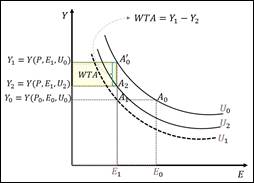
Figure 2 WTA for agrobiodiversity conservation of native crop varieties. Initially, the individual consumption of an agrobio-diversity farmer is 𝐴 0 , and the utility is represented by curve 𝑈 0 . If the use of genetic resource (seeds) by the farmer decreases from 𝐸 0 to 𝐸 1 , theoretically, the utility level falls to 𝑈 1 . Therefore, the farmer status becomes 𝐴 1 . On the other hand, the farmer will also benefit from agrobiodiversity. Thus, his level will become with , and the state changes to
, and the state changes to  . The logic of WTA is to grant monetary compensation to farmers to maintain the same level of utility
. The logic of WTA is to grant monetary compensation to farmers to maintain the same level of utility  . Therefore, WTA that guarantees that the farmer state remains unchanged after continuing to use native varieties to maintain resources is
. Therefore, WTA that guarantees that the farmer state remains unchanged after continuing to use native varieties to maintain resources is  .
.
We can express the WTA compensation expected by the farmers using the following formula. Although it is used in other approaches (Chu et al., 2020; Feng et al., 2018; Wooldridge, 2015), it can be adopted in these circumstances.
Where expected WTA compensation  of the response is related to landraces or variety-conservation programmes.
of the response is related to landraces or variety-conservation programmes.  is the degree of WTA compensation for
is the degree of WTA compensation for  options, and
options, and  represents the WTA compensation probability.
represents the WTA compensation probability.
5. Global evolution of the conservation of PGRs for food and agriculture
Many organisations and individual scientists worldwide have conducted efforts to conserve PGRs. During the period from 1961 to 2023, systematic conservation planning for governance of agrobiodiversity has also expanded to include multiple international covenant on access and benefit sharing (Dempewolf & Krishnan, 2023; Negri et al., 2009), as detailed in the International Treaty on Plant Genetic Resources for Food and Agriculture (Table 1), Convention on Biodiversity, Nagoya Protocol, and Plan of Action for Plant Genetic Resources for Food and Agriculture (2010). During this time, more than 53 relevant events were conducted to establish and develop instruments related to the conservation and sustainable utilisation of PGRs (Dulloo, 2021; Farooq & Pisante, 2019; Sonnino, 2017).
Historically, the international agricultural research centres focused on accession collection systems and ex situ conservation (Brush, 2000; Engels & Ebert, 2021b; Sonnino, 2017). This conservation type involves conserving species outside their agroecosystems. The current state of ex situ conservation and management of PGRs around the world is shown in Figure 3 which illustrates that approximately 5.4 million accessions of germplasm have been collected in 2021, indicating that more than 50,000 plant species are being conserved in over 1750 genebanks worldwide (FAO, 2019; Farooq & Pisante, 2019; Pilling et al., 2020).
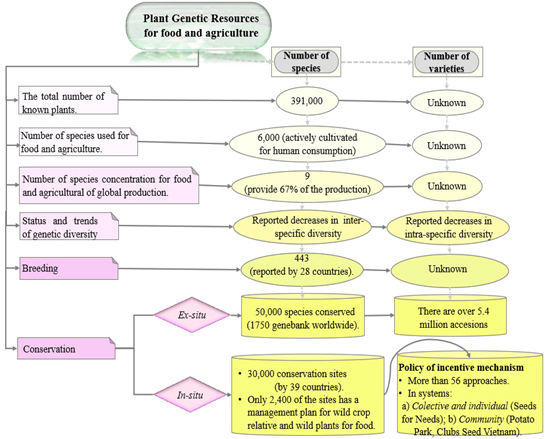
Figure 3 Current status of PGRs for food and agriculture worldwide [based on the FAO Genebank Standards (FAO, 2019), which is adopted from Pilling et al. (2020) and Engels & Ebert (2021b)].
Despite this progress, even if these accessions meet high standards of facilities for ex situ conservation, genebanks will likely be insufficient to respond to the alarming increase in threats posed by climate change and the demand for more food, especially in cases of landraces and wild crop varieties because they are poorly represented. Non-staple crops account for only 2% of the stored materials in genebanks (Farooq & Pisante, 2019).
In 1967, the FAO Conference introduced the issue of complementarity between ex situ and in situ strategies for the conservation of genetic resources. However, only few countries concentrated on working in both directions as a conservation system, and their initiatives were not systematically focused. According to the latest FAO report, 30,000 in situ conservation sites exist worldwide, but only 9% have management plans for wild crop varieties (FAO, 2019; Pilling et al., 2020). The closest plan that integrates in situ conservation into systematic governance of PGR is found in Vietnam in its ‘Seeds for Needs’ programme where the Southeast Asian Regional Community and Can Tho University are collaborating for sustainable conservation. ‘Seeds for Needs’ was established to consider plant-breeding participation where custodian farmers have the opportunity to make decisions at all times to improve crop varieties (Fadda et al., 2020). On the other hand, since Swaminathan (2002) proposed the in situ conservation that uses a community approach, two sustainable systems have been reported. One is the ‘Scarascia Mugnozza Community Genetic Resources Centre’ located in Chennai, India, with Italian funding (Sonnino, 2017). The other is the ‘Potato Park’ in Peru with international financing where families perform conservation services for which they receive compensation (Graddy, 2014). It is also good to mention that there are special agroecosy-stems where the genetic diversity and wild relatives of some crops stand out. Just as an example, we mention barley here, the diversity of native varieties of this crop exists in many parts of the world, but in the most prosperous agroecosystems found in Ethiopia and East Asiatic, however, due to opportunity cost, some areas are being replaced by commercial varieties (Visioni et al., 2023).
Globally, more than 56 incentive-mechanisms structures have been identified (Bellon et al., 2015a; Jarvis et al., 2011). Several examples of compensation schemes exist to include the cost that is not rewarded in the market by in situ conservation, including both genetic diversity and cultural identity (Joshi et al., 2020a). However, developing efficient governance of genetic resources is necessary.
6. Systematic planning for farm (in situ) conservation of PGRs for food and agriculture
This section highlights the importance of mana-ging in situ conservation of agrobiodiversity (on-farm) as a systematic mechanism for benefit analysis. The most recent approaches suggest the integration of in situ conservation with ex situ conservation management to achieve efficient management of PGRs, especially in terms of governance of local agrobiodiversity (Figure 4). One of the key points in integrating systems and concentrating efforts is the incentive mechanism for farmers who conserve landraces and wild crop varieties. This approach should focus on the following: i) enhancing trust and mutual understanding of the systematic conservation among stake-holders and ii) providing differentiated incentive mechanisms that consider decision making, benefits and opportunity costs for the custodian farmer which are explained below.
The implementation of a participatory approach to genetic improvement that allows coordination between in situ and ex situ conservation can enhance trust and increase the effectiveness of the adoption of in situ conservation programmes by custodian farmers or the community (Engels & Ebert, 2021b; Fadda et al., 2020; Louafi et al., 2021; Maxted & Brehm, 2022). Agrobiodiversity-conservation strategies include ex situ and in situ approaches (Rajpurohit & Jhang, 2015; Ramirez‐Villegas et al., 2020), which are not mutually exclusive but are complementary components of conservation programmes (Sonnino, 2017). There-fore, developing a multidimensional appr-oach is needed for sustainability of local agriculture without damaging the social, economic and environmental integrity (Farooq & Pisante, 2019).
In situ conservation (on-farm) can certainly continue because the participation of farmers as human component is a vital part of in situ conservation, which can drive evolution and ensure availability of germplasm for future generations while simultaneously enforcing tough selection pressure through active management to obtain desirable characteristics (Bellon et al., 2015a; Gotor et al., 2017). Similarly, willingness to participate in conservation programmes has been shown to increase when the farmer is involved in the genetic-improvement approach (Fadda et al., 2020), thereby generating more trust against more risks faced by the custodian farmer (Rojas et al., 2014). Many methods are available for integrating the custodian farmer to a systematic conservation programme, although most of them are expensive and inefficient (Jarvis et al., 2006). In the present study, we identify two alternatives that are highly recommended by experts. The first one refers to facilitating access by custodial farmers to the germplasm bank materials (seeds), and the other involves the establishment of a low-cost early-monitoring plan (Bellon et al., 2017; Drucker & Ramirez, 2020; Zair et al., 2021).
Figure 4 shows the iterative cycles that require monitoring. Periodic updating of the collections is needed to continue the conservation cycle. However, the farmers would unlikely be able to integrate some active accessions (sample for the genebank) (Maxted et al., 2000), which is an additional process. This limitation can be overcome by implementing payment mechanisms for conservation services that include training according to the needs of the areas with high agrobiodiversity (Maxted et al., 2016; Midler et al., 2015; Narloch et al., 2013; Wainwright et al., 2019b; Zimmerer et al., 2019). As an example, we can cite a pilot monitoring model that was reported in Ecuador that used cell-phone messages where farmers sustainably and quickly adopted an agricultural programme (Larochelle et al., 2019).
The purpose of linking in situ conservation to a complete PGR governance system is related to the decision making of the farmers regarding the use and management of landraces and wild crop varieties (Allen et al., 2019; Maxted et al., 2016). Researchers face the enormous task of implementing participatory-action approaches to ensure that farmers or communities, who perform conservation on their farms, are the people who decide to safeguard genetic resources in the programme. Indeed, the site for its intervention is defined by analysing many factors associated with significant genetic diversity of the crop (agro-ecological), socio-economic and cultural factors.
Because market incentives and intensive production systems favour a limited base of improved crop varieties, many countries have experienced a decline not only in agrobiodiversity but also in the human capacity to conserve native and wild varieties of crops. Therefore, they urgently need to implement mechanisms that incentivise the farmers. The provision of public benefits necessitates state-policy interventions because of the important public services provided by the in situ conservation of agrobiodiversity. Many of these benefits are regional, national and even reflected in global exchange (Narloch et al., 2011).
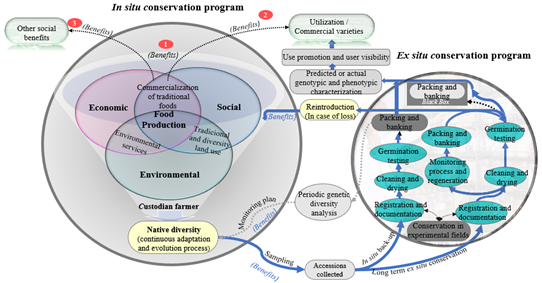
Figure 4 Iterative cycles of PGRs and possible pathways of benefits from the in situ conservation linkage in an integrated system. An integrated in situ and ex situ conservation system primarily refers to the exchange and transfer of materials in both directions. In situ back-up accessions periodically go via the conservation route to the germplasm bank (registration, germination test, packaging, and storage). The periodic monitoring plan should be registered and systematised where in situ conservation continues to provide private and public benefits (social, economic, and environmental). Therefore, PGRs are conserved in both approaches, and users actively use them (formal germplasm supply) (Maxted et al., 2016). This process allows improvement of the inventory of crop genetic diversity. In addition, it reduces management costs (See Table 1) in the ex situ part. However, emphasising that monitoring efforts focus on rare genetic variation is important (Leroy et al., 2018; Zair et al., 2021). Currently, it also provides the incentives that the farmers need to manage the evolution of the crops in their fields (Bellon et al., 2017). In situ conservation is an extremely complex process, as suggested by many studies. Efforts should be focused on areas with high agrobiodiversity, particularly in areas where the species originated and where the probability of complying with the conservation of agrobiodiversity at all levels will be greater (Jarvis et al., 2011). The monitoring carried out by the ex situ part clearly should not disturb the natural-evolution process in the germplasm (Maxted et al., 2016).
However, in situ conservation decisions are made at the farm level in which benefits are received and costs are incurred by individual households (Midler et al., 2015; Nordhagen et al., 2017). Pascual and Perrings (2007) were the first to report the different decision criteria taken by conservationist farmers in their desire to undertake regenerative actions for in situ agrobiodiversity-conservation programmes. They identified the following four important criteria: a) role as manager of their lands, b) economic benefits derived from diversity, c) ecological suitability and d) farmer perception on financial and economic feasibility. On the other hand, we also found other reports that identified more important socio-cultural criteria related to maintaining the quality of agricultural land for future generations, food security and climate change (Sardaro et al., 2016). The most recent advances in decision making by custodians farmers of diversity have multiple goals (Isbell et al., 2021; Wainwright et al., 2019b). Decision making changes according to the rural areas, customs, farmer characteristics and farm structure (Sardaro et al., 2021).
7. Identifying public and private benefits for custodian farmers in conservation
The use of agrobiodiversity is of concerned for the good of the public in general and private individuals, which is why it is known as the provision of a semi-pure public good (Smale et al., 2004). From an economic perspective, public good refers to a benefit that does not involve rivalry and exclusion. From this perspective, an in situ conserved plant genetic diversity can be used by two individuals, and they can be equally satisfied, which means that no rivalry exists. Likewise, it is not exclusive because preventing another individual from also benefiting from its conservation is almost impossible (Bellon et al., 2015a; Pascual & Perrings, 2007).
Hence, recognising that the long-term management of genetic resources is for the good of the public is necessary. Therefore, countries provide multiple public benefits (Pilling et al., 2020). These benefits are related to not only the plant genetic diversity but also the agro-ecosystem balance (environmental services) and wellbeing of humanity (external benefits of on-farm agrobiodiversity) (Bellon et al., 2015b; Jarvis et al., 2008; Krishna et al., 2013; Wainwright et al., 2019b). Simultaneously, genetic resources also appear as good to private individuals because they provide private benefits to the farmers or communities that conserve them (Bellon et al., 2015a; Hanley & Perrings, 2019).
The importance of conserving the plant genetic diversity for future global food security primarily lies in the establishment of germplasm banks for plant breeders and other future users. In situ conservation allows continuation of the adaptation and permanent evolution of local crops. Similarly, it includes the management of wild cop varieties, that is, it ensures the generation of new genetic combinations in time and space. In addition, conservation of agrobiodiversity in the farm provides multiple socio-cultural, economic and environmental services (see Figure 3). However, the costs are borne by the farmer. In fact, market failure occurs because the value of a semi-public good is not captured in the market transactions. In the absence of mechanisms that internalise such values as a public good can lead to the mainte-nance of less than socially desirable levels of agrobiodiversity (Juvančič et al., 2021; Wainwright et al., 2019b). Even if there is an implemented mechanism to conservation of agrobiodiversity, but it has not considered the decision-making of the farmers, it would be bound to be inefficient, (Bellon et al., 2015a).Therefore, decision making is at different levels on a spatial scale.
On a spatial scale (Figure 5), the structure of the stream of public and private benefits generated by in situ conservation of PGR exhibits a horizontal order (farm → regional → global) (Allen et al., 2019; Pascual & Perrings, 2007). At the global level, close networks of global, national and local governments are responsible for politically directed ex situ conservation programmes (Aubry, 2023; Engels & Ebert, 2021a; Khoury et al., 2015). The farm and regional levels involve direct in situ conservation and indirect ex situ conservation. Separating the benefits according to the levels is a great challenge. The incentive mechanisms for the conservation of agrobiodiversity are determined by political decisions. Thus, different countries have intervened using compensation mechanisms for the conservation services (Jarvis et al., 2011). However, deficiencies and management limitations remain in the integration of complex PGR conservation systems (Börner et al., 2017; Maxted et al., 2016). Thus, the problems are not only political (Perrino & Perrino, 2020) but also scientific and technical.
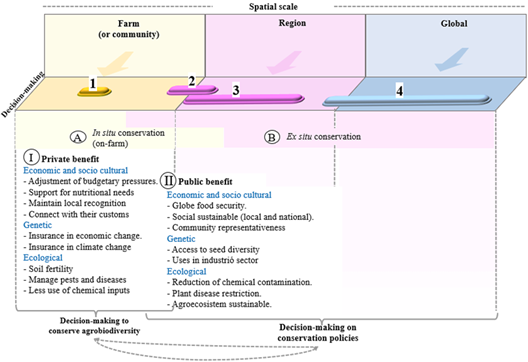
Figure 5 Some potential benefits that are generated in the in situ agrobiodiversity conservation under a comprehensive system. Decision making for each scale. 1. The farmer always decides the species or variety to grow based on multiple criteria. 2. At the national level, decisions are made on the incentive mechanisms to be implemented for in situ conservation. 3. Linking the conservation approaches to improve efficiency. 4 Implementing international agreements in a global scale to promote conservation, such as the Convention on Biological Diversity in Goal 3 of Aichi where the need to implement incentive mechanisms is emphasised (CBD, 2013). The link between the Ⓑ ex situ and Ⓐ in situ conservation approaches shows important contributions in both types of monitoring (genetic variation and the incentives required). Adopting the strategy of diversifying the species or varieties of crops is rational behaviour of the farmer. Therefore, knowing the (I) private benefits for the farmer allows proposing mechanisms that satisfy their priorities because its continuity also provides (II) public benefits. Finally, the decision to create incentive mechanisms is political (Perrino & Perrino, 2020), but the decision to adopt them depends on the farmers or community.
Identification of the individual benefits and opportunity costs creates an important role for public policy to ensure that concepts on the values of agrobiodiversity services are fully integrated into their PGR conservation decisions, which can manifest themselves in differentiated incentive mechanisms (Juvančič et al., 2021). Hence, simpler and more practical tools are needed to assess the farmer objectives (Wainwright et al., 2019b) because the farmer households are not static but are constantly facing new challenges and opportunities, particularly those caused by economic development, environmental and socio-cultural changes. In many cases, they affect the value of maintaining intra-specific or inter-specific diversity, which are mainly associated with the benefits to be obtained from the decisions (Bellon et al., 2017).
8. Conclusions
Compensation to custodian farmers who provide public benefits from conservation of PGRs in farms (in situ) is currently a developing area of research worldwide because of the increasing loss in agrobiodiversity and pressure on farmers to intensify their farms. PGRs face extinction challenges. Thus, proposing more efficient state policies for the management of genetic resources is urgent. Despite the existence of agro-environmental schemes (AESs), conservation of PGRFA has not yet found an instrument to cover the asymmetries in the provision of this type of goods. This study reviews the conservation status of PGRs. For the first time, we present evidence that allows us to focus on an integrated link between in situ and ex situ conservation to generate compensation mechanisms for custodian farmers in terms of private benefits.
We found that some countries provided reports on their proposed conservation programmes. However, worldwide information on in situ conservation is relatively scarce. Some reports from the European countries have proposed an integrated conservation perspective in which AES programmes generate links from integrated monitoring to ex situ conservation.
In general, farmers seem willing to participate in any type of compensation scheme that is proposed in different countries. Furthermore, it is possible to capture WTA, so significant progress would be based on generating an assessment of co-benefits through a comprehensive in situ and ex situ conservation system. If achieved, this would open broader perspectives on how custodian farmers show the true opportunity cost by establishing national conservation networks as government policy.














